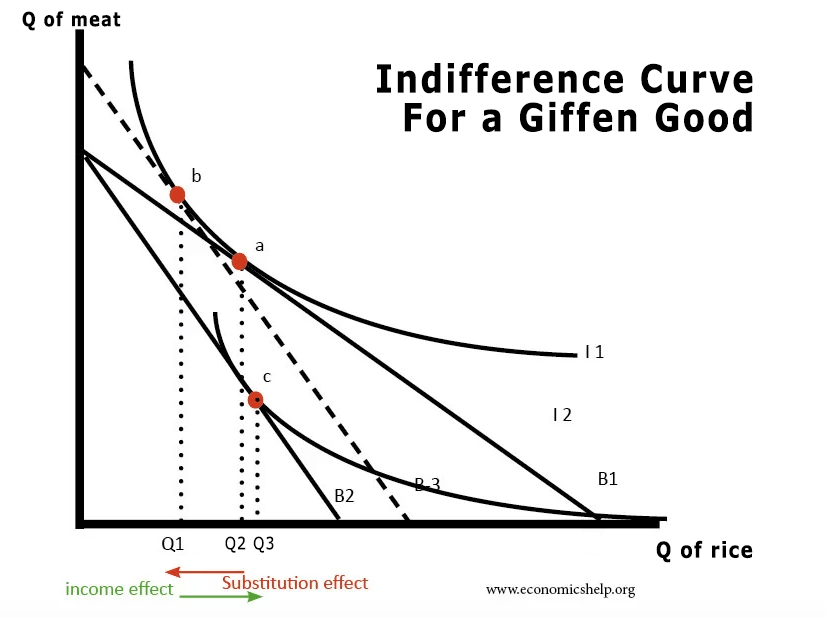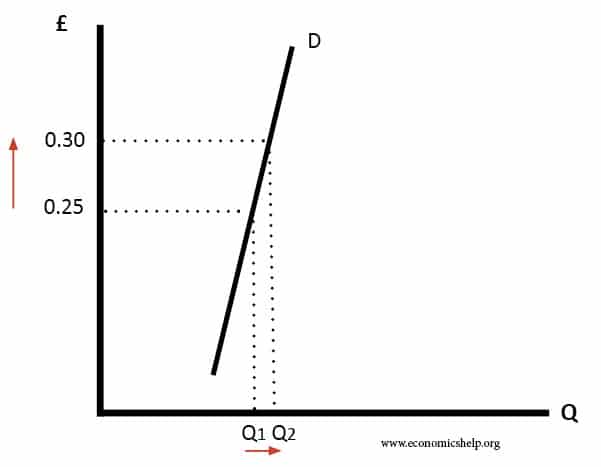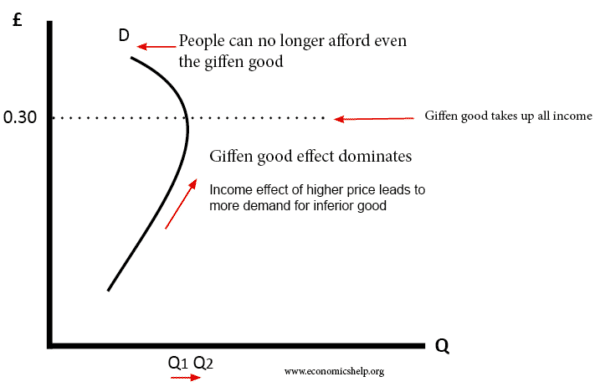Definition of a Giffen Good. A good where a higher price causes an increase in demand (reversing the usual law of demand). The increase in demand is due to the income effect of the higher price outweighing the substitution effect.
- The concept of a Giffen good is limited to very poor communities with a very limited choice of goods. Empirical evidence is hard to find, though some economists thought it applied to the Victorian poor who had a very limited diet.
The idea is that if you are very poor and the price of your basic foodstuff (e.g. bread) increases, then you can’t afford the more expensive alternative food (meat) therefore, you end up buying more bread because it is the only thing you can afford.
“As Mr.Giffen has pointed out, a rise in the price of bread makes so large a drain on the resources of the poorer labouring families and raises so much the marginal utility of money to them, that they are forced to curtail their consumption of meat and the more expensive farinaceous foods: and, bread being still the cheapest food which they can get and will take, they consume more, and not less of it.
Suppose you have a very low income and eat two basic foodstuffs rice and meat.
- Meat is a luxury and is much more expensive than rice.
- If rice increased in price, your disposable income is effectively reduced significantly.
- Therefore, with a reduction in disposable income – you buy less meat
- To compensate for less meat, you buy more rice to gain enough calories.
It is quite rare and whether it really happens has a little uncertainty. But, it shows that there are two factors affecting demand price (substitution effect) and income.
With a Giffen good, if rice continues to rise in prices, demand may eventually fall because the poor workers will not be able to even afford rice.
Diagram of Giffen good
Readers question: This post reminded me of a similar situation: a Giffen good. In fact, Veblen goods and Giffen goods seem to be extremely similar, and I was hoping you could clarify the difference between the two!
The law of demand says a higher price leads to lower demand. However, there are two exceptions
- Veblen Good. In this post, we defined a Veblen Good (sometimes known as ostentatious good). The basic principle is that as price rises people buy more. This is because people think if it is more expensive it must be better quality. This is possible for some designer clothes e.t.c. WIth a Veblen good, the demand curve is shifting to the right – rather than demand upwardly sloping like Giffen good.
- Giffen Good. A Giffen good has the same affect – higher price leads to higher demand. But, it is for a completely different reason. A Giffen good occurs when a rise in price causes higher demand because the income effect outweighs the substitution effect.
Indifference curve analysis and Giffen Goods

We start at Q2, the rise in the price of rice, reduces the budget line for rice to B2. But, the fall in income causes a large income effect that outweighs the substitution effect. Demand for rice rises to Q3 with a big fall in demand for meat.
For more details on indifference curves.
Related



I always thought women’s perfume was a good example of a Veblen product. In many cases men buy it for their partners. To most men all perfume smells the same, therefore the only way to judge if a perfume is a suitable present is the price (and an expensive looking bottle).
A man will be too scared to buy a cheap perfume even if he really likes the smell of it because he does not want to be seen as a cheapskate.
Increase the price of the perfume and demand increases -for male buyers at least!
Good example. Like buying 2nd cheapest bottle of wine in a restaurant rather than cheapest.
The answers are very suitable for me. Nice job